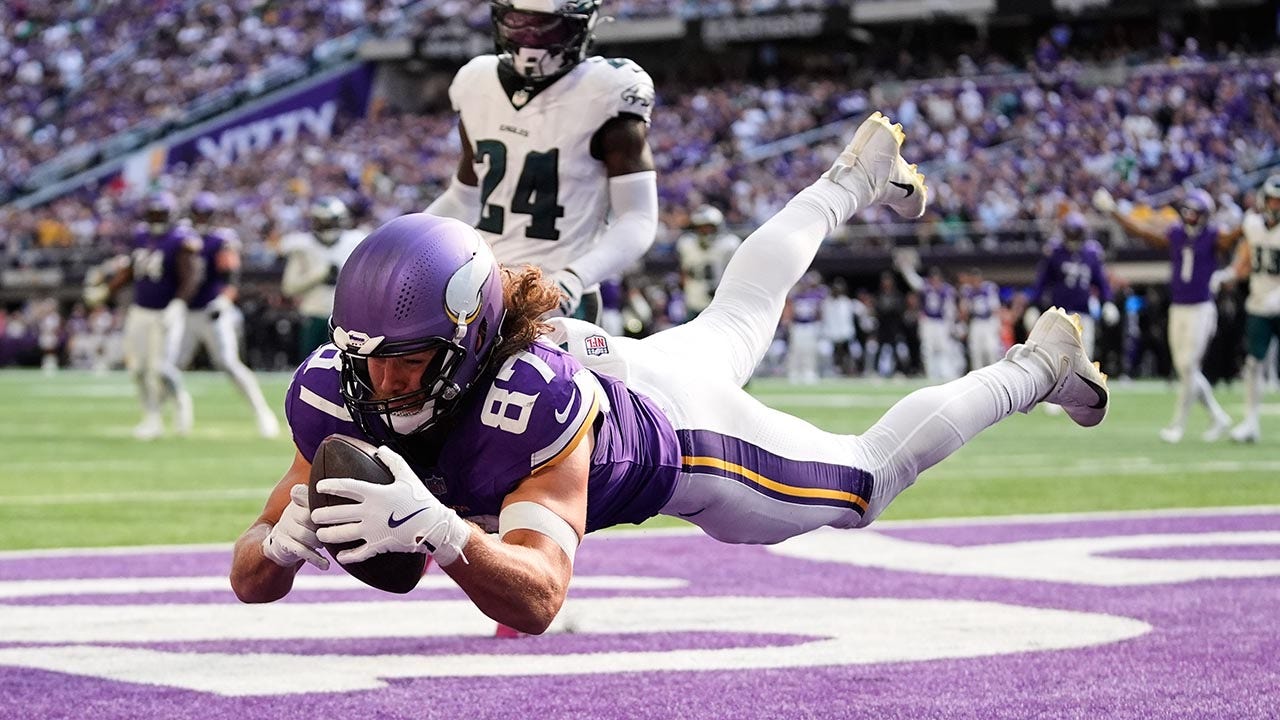In a closely contested NFL matchup on Sunday afternoon, the Philadelphia Eagles edged out the Minnesota Vikings with a 28-22 victory, a game marked by intense moments and controversial calls. The Eagles’ offense showed cohesion and resilience, ultimately proving decisive in securing the win. However, much of the post-game discussion centered around a pivotal and contentious play involving Minnesota Vikings tight end T.J. Hockenson, whose apparent touchdown catch was overturned late in the fourth quarter, altering the course of the game.
With just over three minutes remaining, Hockenson appeared to have made a crucial touchdown reception that would have significantly narrowed the Eagles’ lead. On the field, officials initially ruled the play a touchdown, sparking hope for a Minnesota comeback. However, after a video replay review, the call was reversed, and the touchdown was disallowed. This decision forced the Vikings to settle for a field goal instead, reducing the deficit to six points. Unfortunately for Minnesota, they were unable to regain possession and mount a final offensive push before time expired.
Hockenson, a veteran tight end known for his reliable hands and athleticism, expressed his frustration openly after the game. Speaking to ESPN, he insisted that he had maintained full control of the ball throughout the catch process. “There was nothing to overturn it,” Hockenson said. “I mean, I was out there. I felt it, hands under the ball, snag it and I don't understand. I don't basically understand the catch rule at this point... I don't understand how New York can call in and just be like, ‘Yeah, that's not a catch,’ when there was no evidence that it wasn't. I mean, I had it. I think it's ridiculous.” His comments underscored the confusion and debate surrounding the NFL’s catch rule, which has long been a source of controversy among players, coaches, and fans alike.
The NFL’s replay system, which reviews all scoring plays and turnovers, was at the center of the controversy. Mark Butterworth, the league’s vice president of instant replay, offered an explanation in an interview with a pool reporter. According to Butterworth, the reversal was based on the determination that Hockenson lost control of the ball as he went to the ground, a critical element in the catch rule. “The ruling on the field was a touchdown, so it's replay's jurisdiction to stop the game,” Butterworth said. “We used broadcast-enhanced shots to show that as he was going to the ground — he needs control of the ball throughout the process of the catch — he lost control of the ball. The ball hit the ground. Then, he regained control of the ball. So therefore, we overturned it to an incomplete pass.”
Had the touchdown stood, the Vikings would have been within two points of the Eagles, potentially shifting the momentum and strategy in the final minutes. Instead, the field goal left Minnesota trailing by six, a margin they could not overcome. Despite the disappointment, Hockenson managed to contribute six catches for 43 yards over the course of the game, highlighting his role as a key target in the Vikings’ offense.
Minnesota’s offense struggled at critical moments throughout the game, which compounded the impact of the overturned touchdown. Quarterback Carson Wentz threw interceptions on consecutive drives, including one that was returned for a pick-six by Eagles defender Jalyx Hunt. These turnovers hindered the Vikings’ ability to sustain drives and capitalize on scoring opportunities, ultimately contributing to their defeat.
The Vikings’ head coach, Kevin O’Connell, was seen pacing the sidelines during the second half, undoubtedly grappling with the mounting challenges his team faced. Minnesota’s loss brought their record to an even 3-3 for the season, reflecting a team still searching for consistency and momentum as the campaign progresses.
On the other side, the Eagles’ offense showcased a balanced and effective performance that allowed them to maintain a lead and close out the game under pressure. Commentators Adam Amin and Greg Olsen highlighted the Eagles’ offensive unity as a key factor in their victory, noting how the team’s execution in critical moments made the difference.
This game encapsulated the drama and unpredictability of NFL football, where split-second decisions and replay reviews can dramatically influence outcomes. The controversy over the catch rule once again sparked debate about the clarity and fairness of NFL officiating standards, especially in high-stakes situations. For the Vikings and their fans, the overturned touchdown represented a painful turning point, while for the

